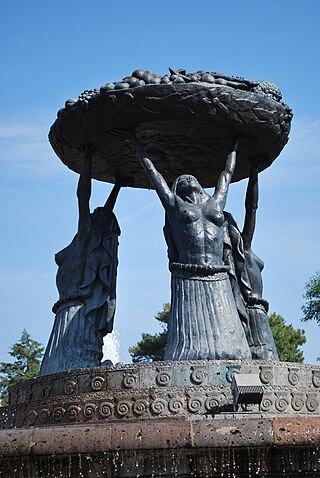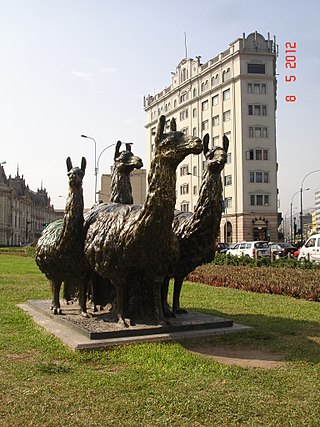
Raúl Porras Barrenechea was a Peruvian diplomat, historian and politician. He was President of the Senate in 1957 and Minister of Foreign Affairs between 1958 and 1960. A well-known figure of the student movement in San Marcos in the early 20th century, Porras became one of the most prominent hispanist historians of his generation and a leading figure of the Peruvian diplomacy.

Presbyter Matías Maestro Cemetery, formerly the General Cemetery of Lima, is a cemetery, museum and historical monument located in the Barrios Altos neighbourhood of Lima District, in Lima, Peru. Inaugurated on May 31, 1808, it was the first pantheon in the city since burials were previously held in the city's churches. It was named in honour of its designer, Spanish priest Matías Maestro.

The Campo de Marte, also known as the Plaza de la Revolución, is a public park in Jesús María District, Lima, Peru. It is one of the largest parks in the metropolitan area of the city, and similar in size to the Park of the Exhibition and the Park of the Reserve. It was originally part of the Santa Beatriz area of Lima District and, from 1903 to 1938, housed the Santa Beatriz Hippodrome until its replacement by the one in San Felipe estate, located further south in the district.

The Parque de la Reserva is a park located in downtown Lima, in Peru. Built in an irregular shape, it is located between two of the city's principal streets, the Paseo de la República expressway and Arequipa Avenue.

The Plaza San Martín is one of the most representative public spaces of the city of Lima, Peru. It is located at the ninth block of Colmena avenue, within the Historic Centre of Lima which was declared a World Heritage Site in 1988 by UNESCO. It is located near the Plaza Mayor of Lima and is connected to it by the Jiron de la Union. Its central monument gives homage to Peru's liberator, José de San Martín.
Jorge Piqueras was a visual artist born in Peru and with Peruvian and Spanish nationality. Jorge Piqueras is recognized as one of the most important Peruvian artists of the twentieth century. Among contemporary Latin American artists, he stands out as a pioneer in geometric painting, as well as for his distinctive sculptural production. Piqueras’ work covers a wide range of materials and media, including sculpture, painting, collage, photography and assemblage.

The Parque de María Luisa is a public park that stretches along the Guadalquivir River in Seville, Spain. It is Seville's principal green area.

The Huntress Diana Fountain stands as a monumental sculptural landmark situated within the roundabout at the intersection of Paseo de la Reforma and Río Misisipí and Sevilla streets. Positioned on the border of the Colonia Cuauhtémoc and Colonia Juárez neighborhoods in Mexico City, this fountain serves as a focal point within the urban fabric of the metropolis. Designed by the Italian architect and sculptor Enrique Alciati, the fountain was unveiled in 1942 and has since become an enduring symbol of Mexico City's cultural heritage and urban landscape. The centerpiece of the fountain is a striking bronze statue depicting Diana, the Roman goddess of the hunt, poised atop a stone pedestal adorned with decorative reliefs and motifs. Adjacent to the Huntress Diana Fountain, several landmarks bear homage to its iconic presence within Mexico City's urban landscape. Among these notable sites are the Cine Diana and two prominent skyscrapers: the Corporativo Reforma Diana and Torre Diana.

The Lima International Exhibition was held in the Park of the Exposition, Lima, in 1872 to attract foreign investment, demonstrate Peru's progress and to mark fifty years since Peru's independence

The Fuente de las Tarascas, also known as the Fuente de la Fertilidad, is a fountain, sculpture and landmark installed in Morelia, Michoacán, Mexico. The original work was created by Antonio Silva Díaz and Benigno Lara and was installed in 1931 in the intersection of Francisco I. Madero Avenue and Acueducto Avenue, in the historic center of the city. The fountain had three colorful concrete statues that depicted three bare-chested, kneeling women holding a basket of fruits. The sculpture was replaced in 1965 by another work.

The Centennial of the Independence of Peru took place on July 28, 1921, as well as in December 9, 1924. To commemorate the hundred years of the country's independence from Spain, large and lavish parties supervised by President Augusto B. Leguía were held.

The Monument to Manco Cápac is a statue located in the homonymous square in La Victoria District, Lima, the work of the Peruvian sculptor David Lozano, inaugurated in 1926.

Débardeur du port d'Anvers, also known as Der Hafenarbeiter is a bronze sculpture created by Belgian artist Constantin Meunier in 1890.

The Moorish Arch, also called the Friendship Arch or Spanish Arch, was a triumphal arch installed at the beginning of Leguía Avenue in Lima, Peru. It was made in a neo-Moorish style, inaugurated in 1924 as part of the Centennial of the Independence of Peru and demolished in 1939.

The Statue of Liberty is a bronze sculpture located in the Plaza Francia of the historic centre of Lima, Peru. It was made in 1926 according to the design of the French sculptor René Bertrand-Boutée and cast by Eugène Soleau. It is a one-piece bronze sculpture about 2 metres high and represents a standing female figure, dressed in a light tunic and with a laurel wreath on her head. This is installed on a 4.30 m high pedestal. The sculpture and the Plaza Francia were declared a monumental urban environment in 1972. In 2018, La Libertad was declared Cultural Heritage of the Nation.

University Park is a public park located in the historic centre of the city of Lima, Peru. It is rectangular in shape and is located at the intersection of Abancay and Nicolás de Piérola avenues.

The German Tower, also known as the Clock Tower or the University Clock, is a clock tower in the historic centre of Lima, Peru. It is located in front of the Casona de la Universidad Nacional Mayor de San Marcos, in the University Park at the intersection of Abancay and Nicolás de Piérola avenues. It was donated in 1921 by the German community in Lima, on the occasion of the Centennial of the Independence of Peru. At twelve in the day and at six in the afternoon, its chimes played the first stanza of the National Anthem of Peru.

Las llamas is a sculpture by Agustín Rivera Eyzaguirre located on the Paseo de los Héroes Navales in Lima, Peru. It was a gift from the Chinese colony in Peru for the fourth centenary of the Spanish foundation of Lima.

La yunta, also known as El trabajo or Los bueyes, is a bronze sculpture in the Paseo de los Héroes Navales, Lima, Peru.

The Chinese Arch, also known as the Chinese Portal, is a paifang located at the entrance of Lima's Chinatown.





















